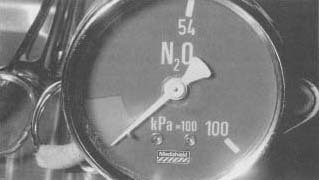Nitrous oxide
Nitrous oxide was first identified by Joseph Priestley in 1772. Years later in the late 1790s, British chemist Humphry Davy (1778-1829) began experimenting with the effects of inhaling nitrous oxide. He noted its exhilarating effects, especially the way it made him want to laugh. This fact helped give the gas its popular nickname, "laughing gas." Davy published his findings in 1800, remarking that "As nitrous oxide … appears capable of destroying pain, it may probably be used with advantage during surgical operations."
Nitrous Oxide and Dentistry
Little attention was paid to Davy's observations or to those of Henry Hill Hickman (1800-1830). Hickman was a general practitioner from Shropshire, England, who in 1824 explored methods of painless surgery on animals using both carbon dioxide and nitrous oxide gas. Davy repeatedly demonstrated the gas's exhilarating effects to gatherings of his friends, and inhalation parties became quite popular. Use spread to the United States as traveling lecturers spread knowledge about the new chemistry to the general public. These lectures usually including a demonstration of the effects of nitrous oxide inhalation on audience volunteers.
A New Anesthetic
One of these public lectures was given in Hartford, Connecticut, in 1844 by Gardner Quincy Colton (1814-1898). It was attended by local dentist Dr. Horace Wells (1815-1848). Wells observed that a volunteer, Samuel Cooley, obviously hurt himself while under the influence of nitrous oxide but didn't notice the pain. Wells immediately thought of using the gas to banish pain during tooth extraction. The next day he took some of Colton's gas while a fellow dentist removed one of Wells's teeth. As he had expected, Wells felt no pain.
After confirming the anesthetic effect of nitrous oxide on other patients, Wells arranged through his former dental partner, William T. G. Morton (1819-1868), to demonstrate his discovery to a group of Morton's Harvard Medical School classmates in January 1845. Unfortunately, the nitrous oxide was applied incorrectly, and the patient yelped with pain when his tooth was pulled, embarrassing Wells before the group.
After Morton used ether successfully as an anesthetic in 1846, Wells pressed his claims for primacy as the discoverer of anesthesia. Frustrated

A Practical Anesthesia
Nitrous oxide was finally made a practical anesthetic by Colton in 1863. Edmund Andrews (1824-1904), a Chicago surgeon, began to use nitrous oxide in combination with oxygen in 1868. As this method gained popularity, nitrous oxide became a staple in surgical as well as dental practice.
Comment about this article, ask questions, or add new information about this topic: